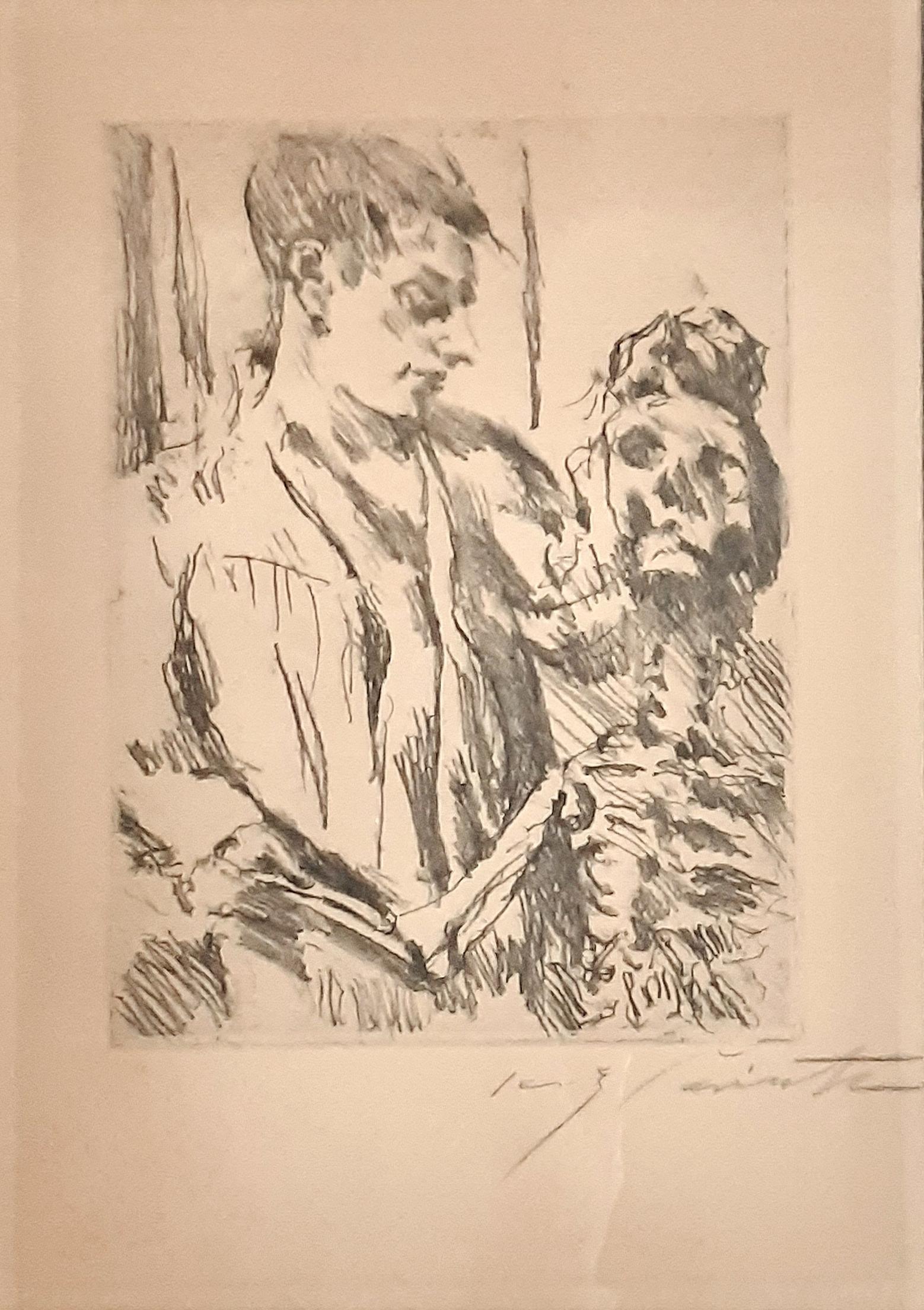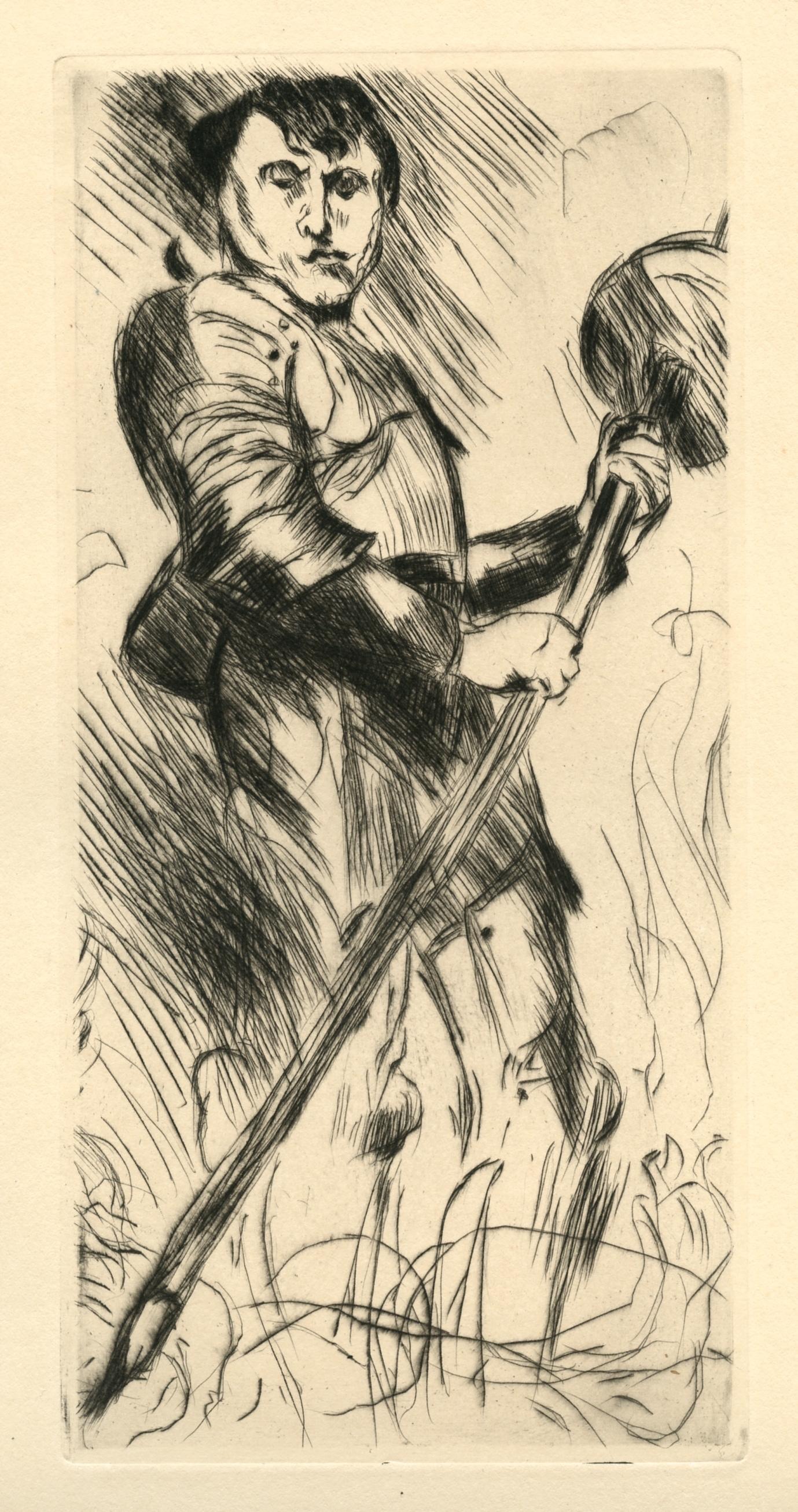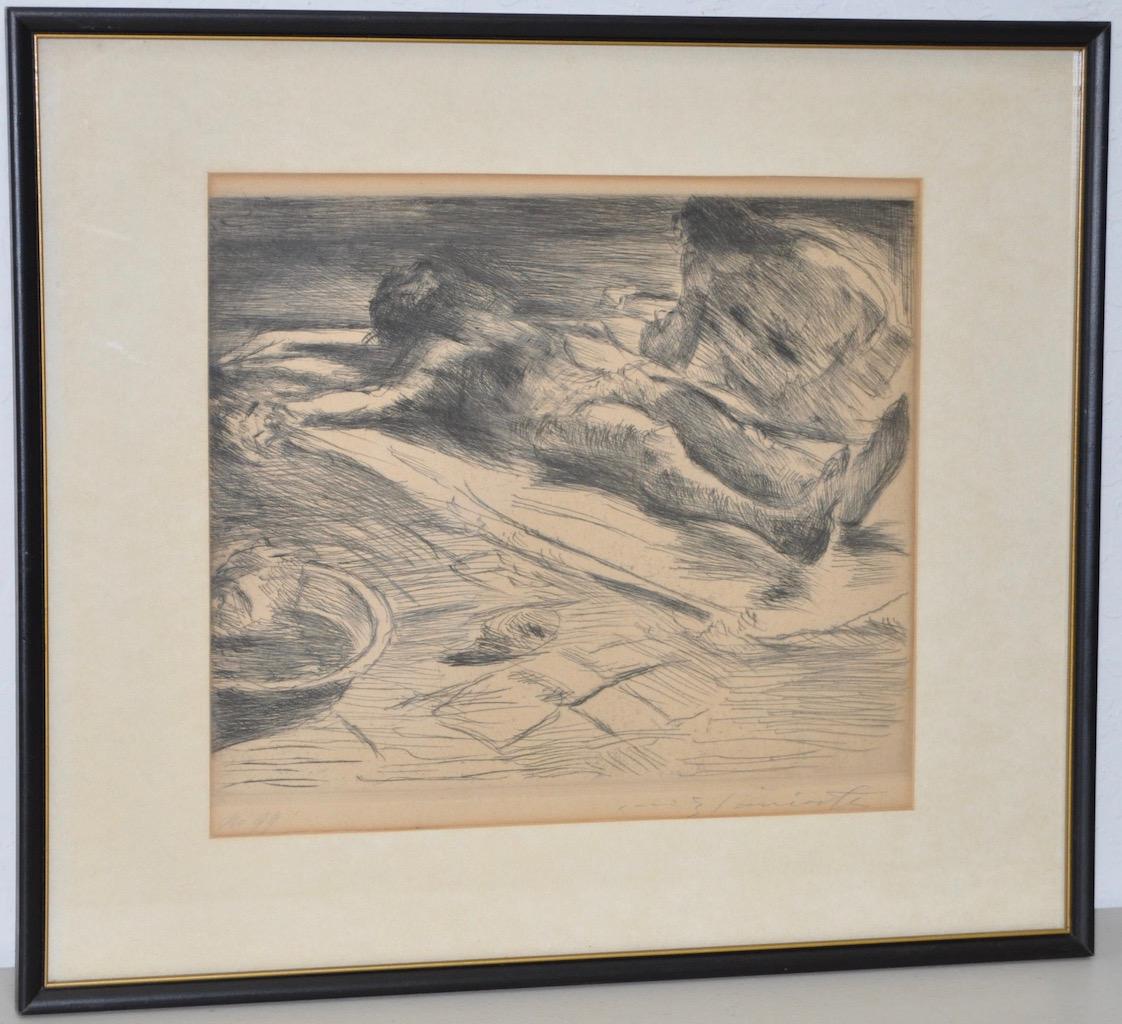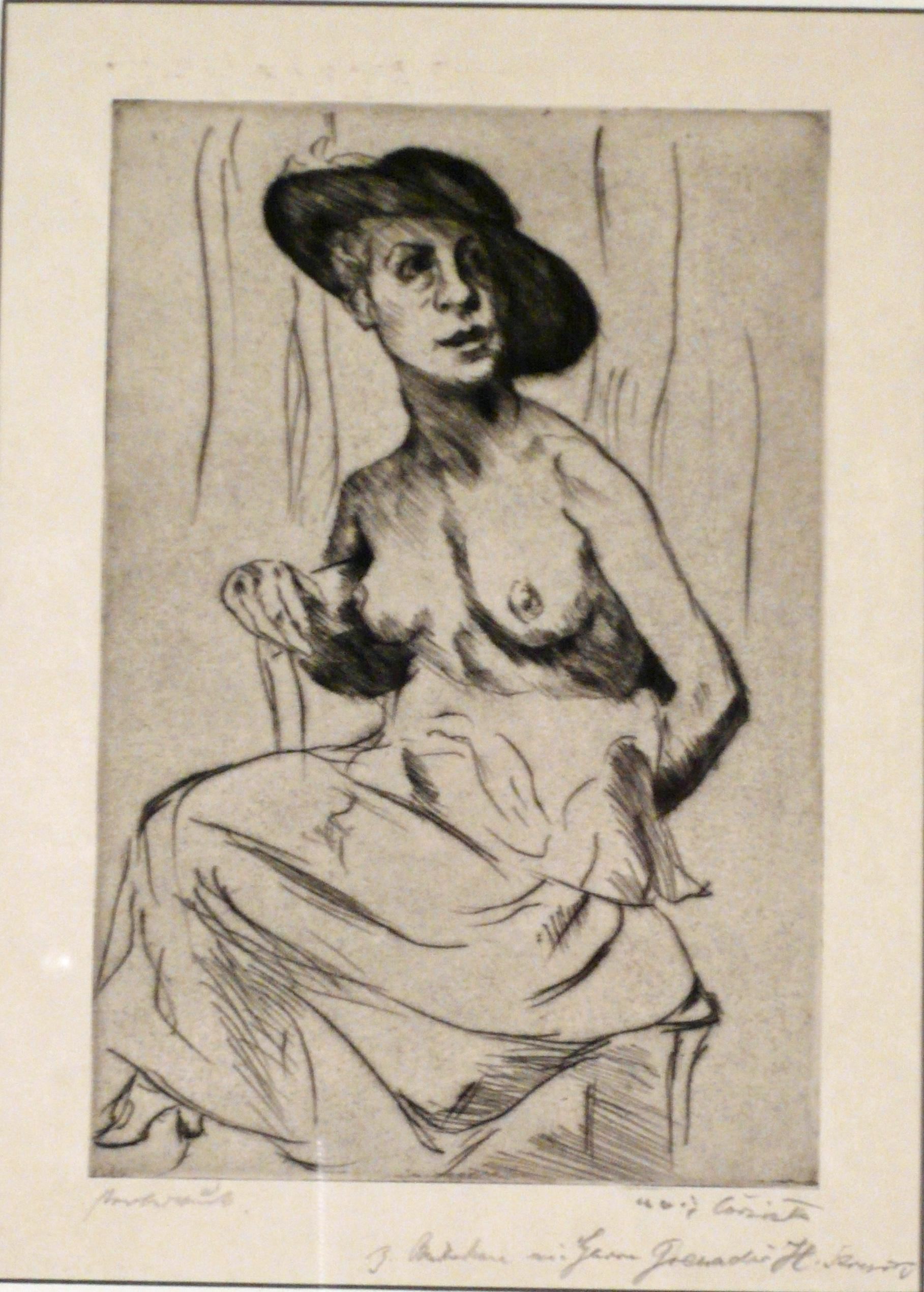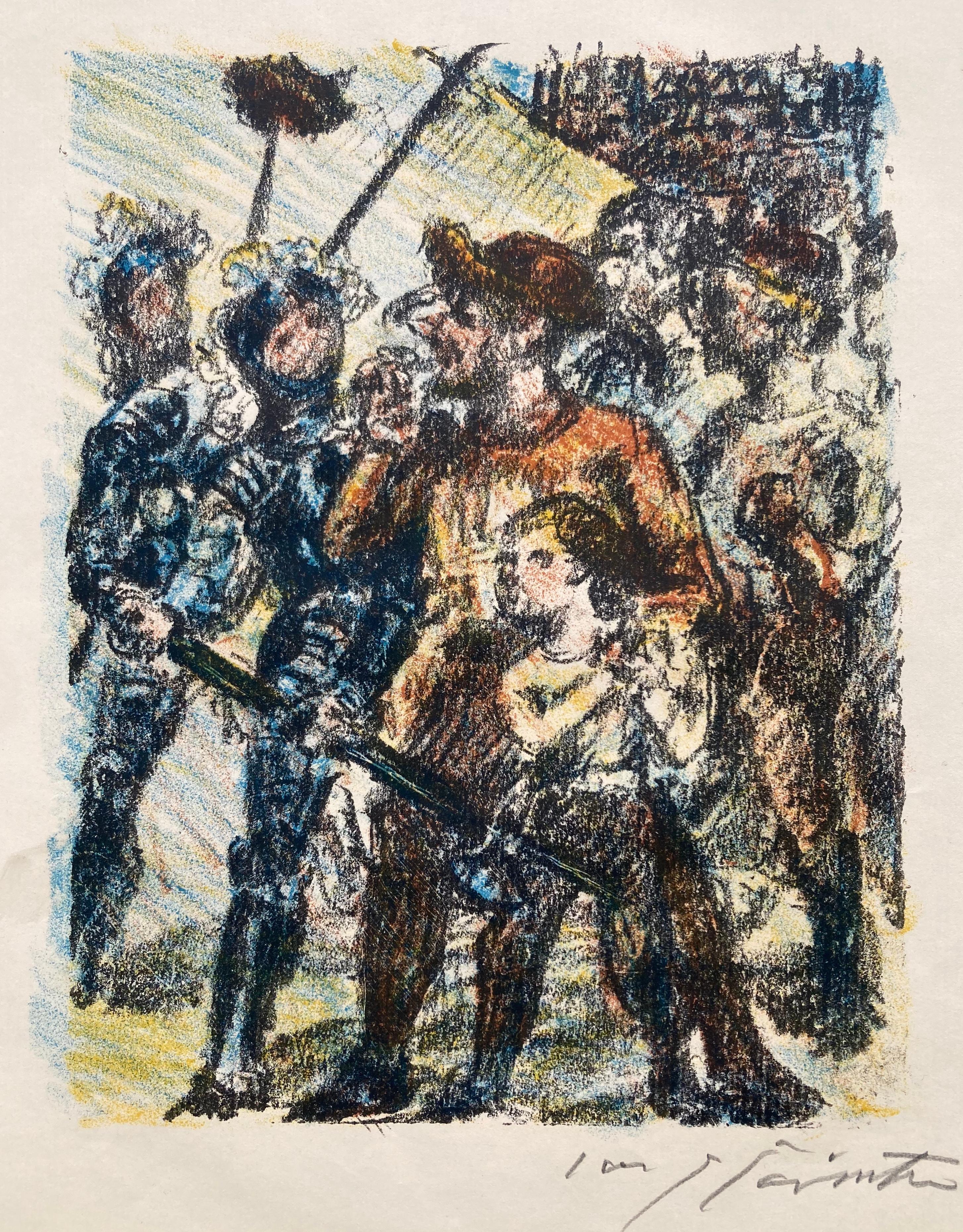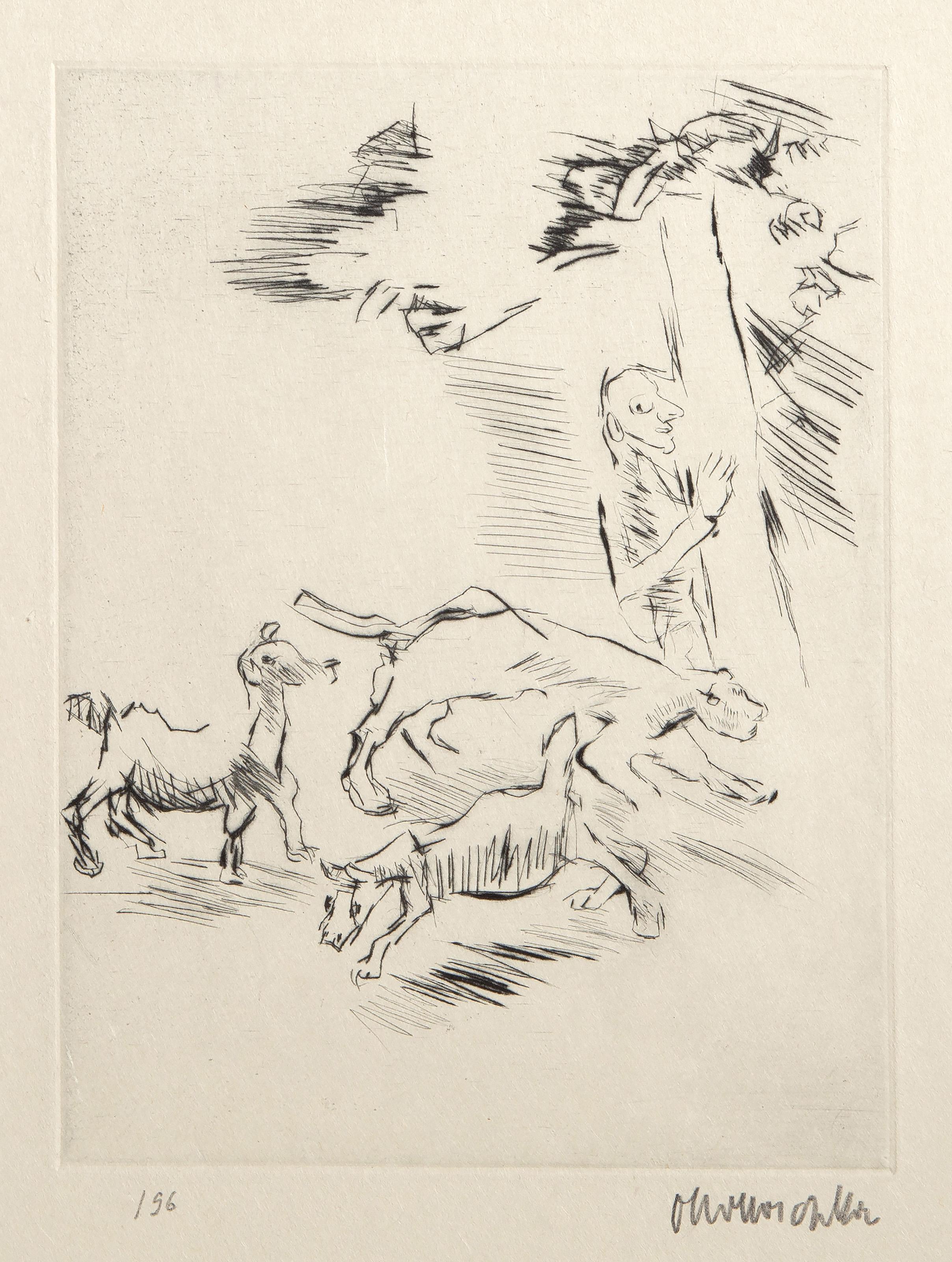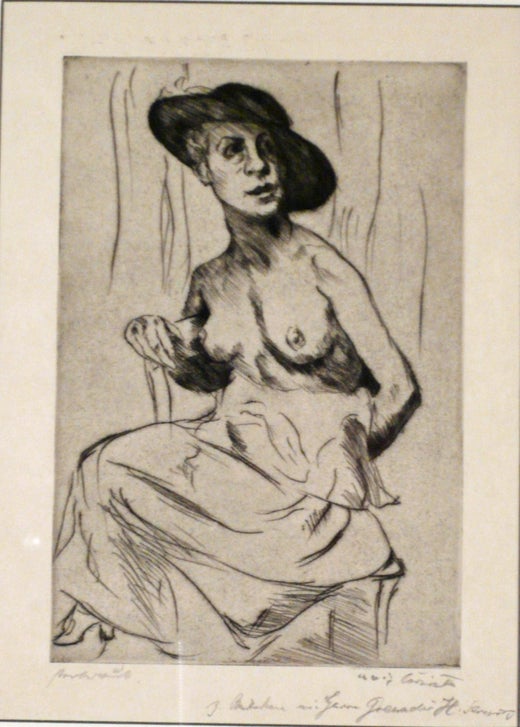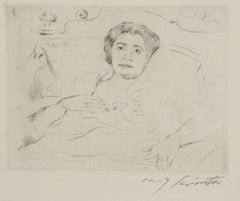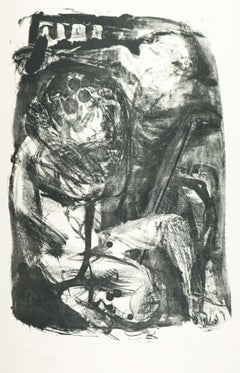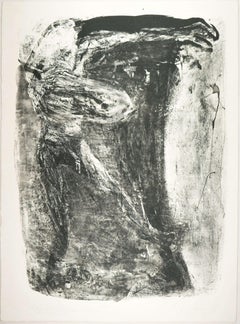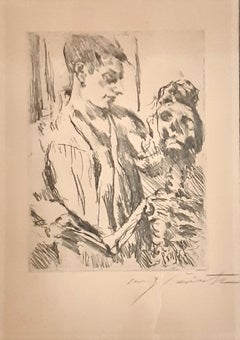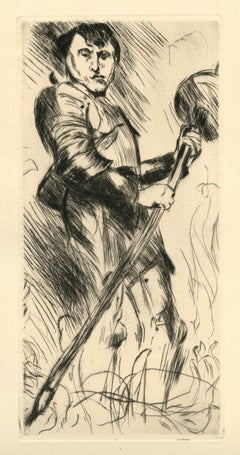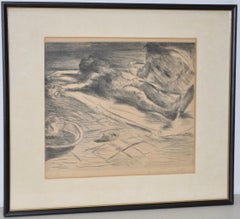Items Similar to Rudolf v. Rittner as Florian Geyer - Last man standing -
Want more images or videos?
Request additional images or videos from the seller
1 of 6
Lovis CorinthRudolf v. Rittner as Florian Geyer - Last man standing -1924
1924
$918.78
$1,148.4720% Off
£673.44
£841.8020% Off
€760
€95020% Off
CA$1,263.68
CA$1,579.6020% Off
A$1,376.18
A$1,720.2220% Off
CHF 723.10
CHF 903.8820% Off
MX$16,811.03
MX$21,013.7820% Off
NOK 8,981.32
NOK 11,226.6520% Off
SEK 8,493.04
SEK 10,616.3120% Off
DKK 5,786.63
DKK 7,233.2920% Off
About the Item
Lovis Corinth (1858 Tapiau - 1925 Zandvoort), Rudolf von Rittner as Florian Geyer, 1924 (Müller 854), drypoint signed in pencil. 20.4 × 14.2 (plate size), 37.7 × 30.6 cm (sheet size). Published by Karl Nierendorf, Berlin. Framed in a passepartout.
- Strong, precise impression. Frame a little bit rubbed and with two small damages.
About the artwork
The knight is a leitmotif in Lovis Corinth's work, culminating in his Self-Portrait in Armour of 1914. Of all the paintings on this theme, Corinth most often depicted Florian Geyer. Descended from a Franconian noble family, he fought for the freedom of the peasants during the peasant wars of the Reformation, first diplomatically and then militarily, leading the legendary Schwarzen Haufen (Black Troops). The name derives from the black uniforms with which Geyer dressed the peasants willing to fight.
During the Napoleonic occupation, the freedom fighter Florian Geyer was sung about by the Romantics, and the free corps Die Schwarze Schaar, founded in 1813 by Major von Lützow, succeeded the Schwarzer Haufen. It was against this historical background that Gerhard Hauptmann wrote the revolutionary drama Florian Geyer, which premiered at the Deutsches Theater in Berlin in 1896. While the actor Rudolf Rittner, who would later appear in Fritz Lang's films, initially played the role of Schäferhans, he took over the leading role in the new production at Berlin's Lessing Theatre in 1904, again directed by Emil Lessing, which established his fame as an actor. Hauptmann himself praised the acting. He wrote to Hugo von Hofmannsthal: "It went quite well with Florian Geyer. In any case, I had the great pleasure of seeing the play again in an admirable performance". And Lovis Corinth was so taken with Rittner's performance that he painted an oil portrait of him in the role of Florian Geyer in 1906.
After two further graphic versions in 1915 and 1920/21, Corinth returned to the painting a year before his death and almost twenty years after the oil painting to create this graphic version in 1924. Even the inscription in the picture was taken over. This proves all the more the importance of the knight and freedom fighter for Corinth's self-image.
The oil painting, in particular, proclaims the single-minded determination to fight to the last for the values defended, manifested in the oil painting by the tattered flag held out to the enemy. There is a parallel with Rainer Maria Rilke's 1899 story The Cornet, in which the protagonist goes down with the flag that he first saved at the risk of his life.
Consequently, the portrait is also a self-portrait, and the knight's armour is not an academic costume or an ironic refraction, but an expression of Corinth's self-image, which also includes his self-representation as an artist. The Secession poster for the exhibition of his life's work in 1913 depicts Florian Geyer. Art is also a struggle, the will to gain more and more ground through one's work. In this sense, Corinth is an avant-gardist without being part of the avant-garde. He is a lone fighter, not a member of a fighting group - Florian Geyer without his Schwarzem Haufen, all alone. For Corinth, this fight had its own fateful dimension: it was the fight with and against his own body after the paralysis caused by the stroke he suffered in 1911. And if we compare the exemplary oil painting with the late etching, for example the shape of the head or the left arm, the ductus itself seems like a battle event from which the knight emerges. This gives the etching its own artistic quality compared to the oil painting.
About the artist
Determined to become an artist, Corinth entered the Königsberg Art Academy in 1876, where he studied under Otto Günther, who introduced him to Weimar plein-air painting. On Günther's recommendation, Corinth moved to the Munich Art Academy in 1880. There, under the influence of the circle of Leibl and Wilhelm Trübner, he adopted a naturalistic approach to art that was opposed to academic history painting.
After interrupting his studies for a year to do voluntary military service, Corinth went on a study trip to Italy in 1883 and the following year to Antwerp, where he took art lessons from Paul Eugène Gorge. From 1884 to 1887, Corinth stayed in Paris and devoted himself mainly to nude painting at the private Académie Julian.
After a stopover in Berlin, where he met Max Klinger, Walter Leistikow and Karl Stauffer-Bern, Corinth lived in Munich from 1891 to 1901 and became a founding member of the Munich Secession, which was founded in 1892 by Max Liebermann, Otto Eckmann, Thomas Theodor Heine, Hans Olde, Hans Thoma, Wilhelm Trübner, Franz von Stuck and Fritz von Uhde. The Secession gave rise to the Free Association of the XXIV or Munich 24, to which Corinth also belonged.
In 1894, under the tutelage of Otto Eckmann, Corinth learnt the art of etching and, in the field of painting, developed the wet-on-wet style that would characterise his work and lead to the relief-like texture of his paintings.
His relationship with Berlin became more and more intense. When he attended the first exhibition of the Berlin Secession in 1899, he painted a portrait of Liebemann, who in turn painted a portrait of Corinth. After the Munich Secession rejected his painting Salome, he finally moved to Berlin, where the painting was admired at the Secession exhibition and Corinth - through Leistikow - became a much sought-after portraitist.
In 1903 Corinth opened an art school and in 1904 he married his first pupil, Charlotte Berend. His first solo exhibition was organised by Paul Cassirer. In Berlin, Corinth also began to devote himself to the theatre. He worked with Max Reinhardt, designing sets and costumes.
Following Max Liebermann's resignation, Corinth was elected chairman of the Secession in 1911. In the same year, he suffered a stroke that paralysed half of his body. He then devoted himself intensively to graphic art and opened up the field of book illustration.
In 1913, Paul Cassirer organised the first major retrospective of Corinth's work, and in 1918, on his 60th birthday, the Berlin Secession devoted a major exhibition to his work. In 1923, on his 65th birthday, his artistic career was crowned with a extense solo exhibition at the National Gallery.
Even after the 'Freie Sezession' split from the 'Berliner Sezession', Corinth remained in the original association, becoming chairman again in 1915 and professor at the Berlin Academy of Arts the following year.
In 1919, the Corinths purchased the retreat at the Walchensee in Bavaria, which Corinth captured in more than 60 paintings. Corinth died in 1925 on a trip to Amsterdam to see his great idols, Frans Hals and Rembrandt.
Selected Bibliography
Heinrich Müller: Die späte Graphik von Lovis Corinth, Hamburg 1960.
Thomas Deecke: Die Zeichnungen von Lovis Corinth. Studien zur Stilentwicklung, Berlin 1973.
Zdenek Felix (Hrsg.): Lovis Corinth. 1858–1925, Köln 1985.
Karl Schwarz: Das Graphische Werk von / The Graphic Work of Lovis Corinth, San Francisco 1985.
Horst Uhr: Lovis Corinth, Berkeley 1990.
Charlotte Berend-Corinth: Lovis Corinth: Die Gemälde. Neu bearbeitet von Béatrice Hernad, München 1992.
Peter-Klaus Schuster / Christoph Vitali / Barbara Butts (Hrsg.): Lovis Corinth, München 1996.
Michael F. Zimmermann: Lovis Corinth, München 2008.
Thank you for your interest! I hope I have been able to explain to you the special character of the artwork. If you have any questions of any kind, please feel free to contact me.
I wish you many more discoveries in the realm of art,
Dr Martin Kirves
GERMAN VERSION
Lovis Corinth (1858 Tapiau - 1925 Zandvoort), Rudolf von Rittner als Florian Geyer, 1924 (Müller 854), Kaltnadelradierung mit Bleistift signiert. 20,4 × 14,2 (Plattengröße), 37,7 × 30,6 cm (Blattgröße). Herausgegeben von Karl Nierendorf, Berlin. Im Passepartout gerahmt.
- Kräftiger, präziser Abdruck. Rahmen leicht berieben und mit zwei kleinen Fehlstellen.
zum Werk
Der Ritter ist ein Leitmotiv in Lovis Corinths Werk, das in seinem Selbstbildnis im Harnisch aus dem Jahre 1914 kulminiert. Unter den Bildern mit dieser Thematik stellt Corinth am häufigsten Florian Geyer dar. Einem fränkischen Adelshaus entstammend setzte er sich in den Bauernkriegen der Reformationszeit zunächst diplomatisch und dann militärisch für die Freiheit der Bauern ein und führte den legendären Schwarzen Haufen an. Der Name leitet sich von den schwarzen Uniformen her, mit denen Geyer die kampfwilligen Bauern eingekleidet hatte.
Während der napoleonischen Besatzung wurde der Freiheitskämpfer Florian Geyer von der Romantik besungen und das 1813 von Major von Lützow gegründete Freikorps Die Schwarze Schaar trat die Nachfolge des Schwarzen Haufens an. Vor diesem historischen Hintergrund verfasste Gerhard Hauptmann das Revolutionsdrama Florian Geyer, welches 1896 im Deutschen Theater in Berlin uraufgeführt wurde. Hatte der Schauspieler Rudolf Rittner, der später in den Filmen Fritz Langs mitwirken sollte, zunächst die Rolle des Schäferhans inne, übernahm er bei der abermals unter der Regie von Emil Lessing erfolgten Neuinszenierung im Berliner Lessingtheater 1904 die Hauptrolle, mit der er seinen Ruhm als Schauspieler begründete. Hauptmann selbst äußerte sich lobend über die schauspielerische Leistung. An Hugo von Hofmannsthal schrieb er: „Mit dem Florian Geyer ging es ganz gut. Ich habe jedenfalls die sehr große Freude gehabt das Stück wieder zu sehen in bewunderungswürdiger Darstellung.“ Und auch Lovis Corinth war derart von Rittners Darbietung angetan, dass er ihn 1906 in der Rolle des Florian Geyer in Öl porträtierte.
Nach zwei weiteren grafischen Versionen von 1915 und 1920/21 kommt Corinth ein Jahr vor seinem Tod und knapp zwanzig Jahre nach Anfertigung des Ölbildes wieder auf das Gemälde zurück, um 1924 die vor Augen stehende Grafik zu schaffen. Selbst die bildinterne Bezeichnung wurde übernommen. Dies belegt umso mehr die Relevanz des Ritters und Freiheitskämpfers für Corinths Selbstverständnis.
Insbesondere das Ölbild kündet von der zielstrebigen Entschlossenheit bis zum Letzten für die verteidigten Werte zu kämpfen, was sich beim Ölbild in der zerfetzten, aber doch dem Gegner entgegengehaltenen Fahne kundtut. Eine Parallele zu Rainer Maria Rilkes 1899 verfassten Erzählung Der Cornet, in welcher der Protagonist mit der zunächst unter Einsatz seines Lebens geretteten Fahne untergeht.
Das Bildnis ist folglich zugleich ein Selbstbildnis und die Ritterrüstung keine akademische Kostümierung oder eine ironische Brechung, sondern Ausdruck von Corinths Sicht auf sich selbst, was zugleich seine Selbstdarstellung als Künstler beinhaltet. Dementsprechend zeigt das Ausstellungsplakat der Secession anlässlich der 1913 stattfindenden Schau seines Lebenswerks Florian Geyer. Auch die Kunst ist ein Kampf, der Wille, durch das Werk immer weiter Boden zugewinnen. In diesem Sinne ist Corinth ein Avantgardist, ohne allerdings zu einer Avantgarde zu gehören. Er ist ein Einzelkämpfer, nicht Mitglied einer Kampfgruppe – Florian Geyer ohne seinen Schwarzen Haufen, ganz auf sich allein gestellt. Dieser Kampf hat für Corinth noch eine eigene schicksalshafte Dimension: Es ist der Kampf mit und gegen den eigenen Körper nach der Lähmung durch den im Jahre 1911 erlittenen Schlaganfall. Und vergleichen wir das vorbildliche Ölbild mit der späten Radierung, etwa die Gestaltung des Kopfes oder auch des linken Armes, wirkt der Duktus selbst wie ein Kampfesgeschehen, aus dem heraus sich der Ritter manifestiert. Dadurch gewinnt die Radierung gegenüber dem Ölbild eine ganz eigene künstlerische Qualität.
zum Künstler
Entschlossen Künstler zu werden, trat Corinth 1876 in die Kunstakademie Königsberg ein, wo er bei Otto Günther studierte, der ihm die Weimarer Freilichtmalerei nahebrachte. Auf Günthers Empfehlung wechselte Corinth 1880 an die Münchner Kunstakademie. Unter dem Einfluss des Leibls-Kreises und Wilhelm Trübners folgte er dort einem naturalistischen Kunstverständnis, das gegen die akademische Historienmalerei gerichtet war.
Nach einer einjährigen Studienunterbrechung zur Ableistung eines freiwilligen Militärdienstes begab sich Corinth 1883 auf eine Studienreise nach Italien und im Folgejahr nach Antwerpen, wo er bei Paul Eugène Gorge Kunstunterricht nahm. 1884-1887 weilte Corinth in Paris und widmete sich an der privaten Académie Julian vor allem der Aktmalerei.
Nach einer Zwischenstation in Berlin, wo er Max Klinger, Walter Leistikow und Karl Stauffer-Bern kennenlernte, lebte Corinth von 1891-1901 in München und wurde Gründungsmitglied der 1892 ins Leben gerufenen Münchener Secession, der sich Max Liebermann, Otto Eckmann, Thomas Theodor Heine, Hans Olde, Hans Thoma, Wilhelm Trübner, Franz von Stuck und Fritz von Uhde anschlossen. Aus der Sezession ging die Abspaltung Freie Vereinigung der XXIV oder Münchner 24 hervor, zu der auch Corinth gehörte.
Von Otto Eckmann angeleitet erlernte Corinth 1894 die Kunst des Radierens und entwickelte auf dem Feld der Malerei die für sein Werk prägende Nass-in-Nass-Malerei, die zum reliefartigen Duktus seiner Gemälde führte.
Die Beziehungen nach Berlin wurden immer intensiver. Als er 1899 zur ersten Ausstellung der Berliner Secession fuhr porträtierte er Liebemann, der seinerseits ein Porträt von Corinth anfertigte. Nachdem die Münchner Sezession sein Bild Salome abgelehnt hatte, zog er endgültig nach Berlin, wo das Gemälde auf der dortigen Sezessionsausstellung Bewunderung fand und Corinth – von Leistikow vermittelt – zum gefragten Porträtmaler wurde.
1903 eröffnete Corinth eine Malerschule und heiratete 1904 seine erste Schülerin Charlotte Berend. Von Paul Cassirer veranstaltet erfolgte die erste Einzelausstellung. In Berlin begann sich Corinth auch dem Theater zu widmen. Er arbeitete mit Max Reinhardt zusammen, entwarf Bühnenbilder und Kostüme.
Nach dem Rücktritt Max Liebermanns wurde Corinth 1911 zum Vorsitzenden der Secession gewählt. Im selben Jahr erlitt er einen Schlaganfall, der ihn halbseitige lähmte. In der Folge wandte er sich intensiv der Grafik zu und erschloss sich das Feld der Buchillustration.
1913 veranstaltetet Paul Cassirer die erste große Retrospektive und zum 60. Geburtstag Corinths widmete ihm die Berliner Secession 1918 eine großangelegte Werkschau. 1923, zu seinem 65. Geburtstag, wurde seine künstlerische Karriere mit einer umfassenden Einzelausstellung in der Nationalgalerie gekrönt.
Auch nach der Abspaltung der "Freien Secession" von der "Berliner Secession" verblieb Corinth in der ursprünglichen Vereinigung und wurde 1915 erneut Vorsitzender und im Folgejahr zum Professor an der Berliner Akademie der Künste ernannt.
1919 erwarben die Corinths den Rückzugsort am bayerischen Walchensee, den zu Corinths in über 60 Bildern festhielt. Auf einer Reise nach Amsterdam zu seinen großen Vorbildern Frans Hals und Rembrandt verstarb Corinth im Jahre 1925.
Auswahlbibliographie
Heinrich Müller: Die späte Graphik von Lovis Corinth, Hamburg 1960.
Thomas Deecke: Die Zeichnungen von Lovis Corinth. Studien zur Stilentwicklung, Berlin 1973.
Zdenek Felix (Hrsg.): Lovis Corinth. 1858–1925, Köln 1985.
Karl Schwarz: Das Graphische Werk von / The Graphic Work of Lovis Corinth, San Francisco 1985.
Horst Uhr: Lovis Corinth, Berkeley 1990.
Charlotte Berend-Corinth: Lovis Corinth: Die Gemälde. Neu bearbeitet von Béatrice Hernad, München 1992.
Peter-Klaus Schuster / Christoph Vitali / Barbara Butts (Hrsg.): Lovis Corinth, München 1996.
Michael F. Zimmermann: Lovis Corinth, München 2008.
Vielen Dank für Ihr Interesse! Ich hoffe, ich habe Ihnen den besonderen Charakter des Kunstwerks näherbringen können. Bei Fragen jeglicher Art können Sie mich gerne kontaktieren.
Ich wünsche Ihnen noch viele Entdeckungen im Reich der Kunst,
Dr. Martin Kirves
- Creator:Lovis Corinth (1858 - 1925, German)
- Creation Year:1924
- Dimensions:Height: 8.04 in (20.4 cm)Width: 5.6 in (14.2 cm)
- Medium:
- Movement & Style:
- Period:
- Condition:
- Gallery Location:Berlin, DE
- Reference Number:1stDibs: LU2438211991002
Lovis Corinth
Lovis Corinth was a German artist and writer whose mature work as a painter and printmaker realized a synthesis of impressionism and expressionism, known for his dramatic figurative and landscape paintings also for his landscapes of the Walchensee area of Bavaria and his portraits, Corinth also painted religious scenes, often violent . He also made etchings and lithographs in which he revealed his capacity for Expressionist power.
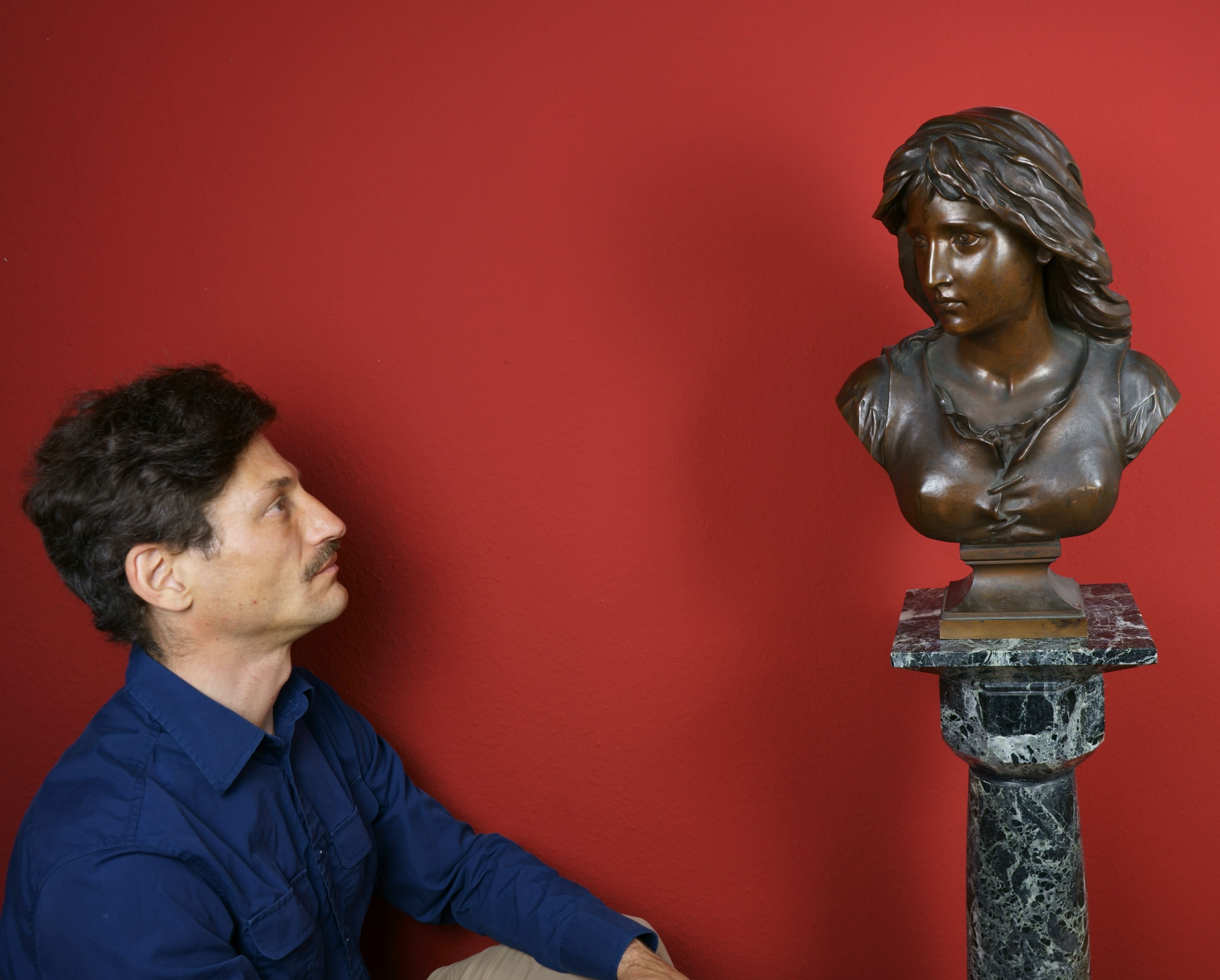
About the Seller
5.0
Vetted Professional Seller
Every seller passes strict standards for authenticity and reliability
Established in 2014
1stDibs seller since 2023
21 sales on 1stDibs
- ShippingRetrieving quote...Shipping from: Berlin, Germany
- Return Policy
Authenticity Guarantee
In the unlikely event there’s an issue with an item’s authenticity, contact us within 1 year for a full refund. DetailsMoney-Back Guarantee
If your item is not as described, is damaged in transit, or does not arrive, contact us within 7 days for a full refund. Details24-Hour Cancellation
You have a 24-hour grace period in which to reconsider your purchase, with no questions asked.Vetted Professional Sellers
Our world-class sellers must adhere to strict standards for service and quality, maintaining the integrity of our listings.Price-Match Guarantee
If you find that a seller listed the same item for a lower price elsewhere, we’ll match it.Trusted Global Delivery
Our best-in-class carrier network provides specialized shipping options worldwide, including custom delivery.More From This Seller
View AllIn bed / - Reverie -
By Lovis Corinth
Located in Berlin, DE
Lovis Corinth (1858 Tapiau - 1925 Zandvoort), In bed, 1909. Drypoint on laid paper with watermark, 14.3 cm x 19 cm (image), 29 cm x 39.3 cm (sheet size), signed “Lovis Corinth” in pe...
Category
Early 1900s Impressionist Figurative Prints
Materials
Paper
Threatening to defeat me once and for all / - A Christmas Pietà -
Located in Berlin, DE
Johannes Heisig (*1953 Leipzig), "Threatening to defeat me once and for all" - To the Christmas Oratorio by Johann Sebastian Bach. Lithograph on strong yellowish laid paper with wate...
Category
1980s Abstract Expressionist Figurative Prints
Materials
Lithograph
$367 Sale Price
20% Off
My treasure, my sanctuary / - A Tortured Treasure -
Located in Berlin, DE
Johannes Heisig (*1953 Leipzig), "My treasure, my sanctuary" - To the Christmas Oratorio by Johann Sebastian Bach. Lithograph on strong yellowish laid paper with watermark, 53 x 39.5...
Category
1980s Abstract Expressionist Figurative Prints
Materials
Lithograph
$367 Sale Price
20% Off
The Prophet / - The Burden of the Prophet -
Located in Berlin, DE
Wilhelm Gross (1883 Schlawe - 1974 Oranienburg-Eden), The Prophet, c. 1955. Woodcut on thin laid paper, 43 cm x 23 cm (depiction), 61 cm x 43 cm (sheet size), signed “Dr. Wilh.[elm] Gross” in pencil lower right, inscribed “Orig.[inal] Holzschnitt (Handabdruck)” lower left and inscribed “Aus der ”Ecce homo“ Folge” in the center.
- The wide margin with traces of pressing due to the impression, the sitter's left foot with a small purple stain, otherwise in vibrant condition.
- The Burden of the Prophet -
The large-format woodcut shows a prophet figure that takes up almost the entire height of the sheet. However, instead of seeing something in the distance that is still hidden from our eyes - as is usual in depictions of prophets - the figure has raised his hands in a defensive gesture, as if the prophet is trying to ward off what he has seen. At the same time, however, the position of the arms is an acceptance of the inevitable, which only those who recognize what is to come will have to bear for the time being, which is why the figure in the painting - despite its size - appears almost solitary, alone and exposed to the burden of suffering.
In a manner reminiscent of the folds of medieval wooden sculptures...
Category
1950s Realist Figurative Prints
Materials
Paper
The actor Karl Seydelmann as soldier / - The expressiveness of a simple pose -
Located in Berlin, DE
Theodor Hosemann (1807 Brandenburg - 1875 Berlin), The actor Karl Seydelmann as soldier, around 1840. Watercolor in pencil, 22 cm (height) x 14.7 cm (width), signed “Th.[eodor] Hosem...
Category
1840s Realist Figurative Drawings and Watercolors
Materials
Paper
The actor Karl Seydelmann, probably as Max Piccolomini / - Theatrical Realism -
Located in Berlin, DE
Theodor Hosemann (1807 Brandenburg - 1875 Berlin), The actor Karl Seydelmann probably as Max Piccolomini, around 1840. Watercolor with pencil, 20.5 cm (height) x 14.7 cm (width), sig...
Category
1840s Realist Figurative Drawings and Watercolors
Materials
Paper
You May Also Like
Tod und Jungling - Lithograph by L. Corinth - 1921
By Lovis Corinth
Located in Roma, IT
Tod und Jungling is an original lithograph, realized by Lovis Corinth in 1921, hand-signed and numbered n°33/95.
Included a wooden frame.
In very good conditions.
Here the artworks represented a man with a strong expression of lines drawn, who has caught with his hand a skeleton, interestingly the skeleton has a sense of fear although the man is free of any frightening emotions.
Lovis Corinth (1858-1925) was a German artist and writer whose mature work as a painter and printmaker realized a synthesis of impressionism and expressionism. known for his dramatic figurative...
Category
1920s Figurative Prints
Materials
Lithograph
"Der Heilige Georg" original etching
By Lovis Corinth
Located in Henderson, NV
Medium: original etching and drypoint. The English translation of the German title is "The Hug". Published in Leipzig, Germany by Zeitschrift fur bildende Kunst in 1915. The plate me...
Category
1910s Prints and Multiples
Materials
Etching
Lovis Corinth (German, 1859-1925) "Pieta" Rare Etching c.1920
By Lovis Corinth
Located in San Francisco, CA
Lovis Corinth (German, 1859-1925) Rare Etching c.1920
Fine etching by noted German Expressionist artist Lovis Corinth.
This striking imag...
Category
Early 20th Century Impressionist Figurative Prints
Materials
Etching
WEIBLICHER AKT MIT BREITKREMPIGEM HUT
By Lovis Corinth
Located in Portland, ME
Corinth, Lovis. WEIBLICHER AKT MIT BREITKREMPIGEM HUT (Female Nude with Broad-Brimmed Hat). Schwartz 226A. Etching, 1916. 11 3/4 x 7 3/4 inches, 300 x 198 mm. The earlier version, be...
Category
1910s Portrait Prints
Materials
Etching
William Tell And His Son In Front Of The Hat
By Lovis Corinth
Located in Santa Monica, CA
LOVIS CORINTH (German 1858 -1925)
TELL AND HIS SON IN FRONT OF THE HAT "(Wilhelm) Tell Und Sein Sohn Vor Dem Hut" 1923 -5, (Muller 781) Lithograph with coloring, signed in pencil. This is one of 25, signed, on Japan paper Total edition 200. Image 9 1/8 x 7 1/4 inches. Full Sheet 15 x 11 1/2 inches with deckle edge. In good condition.
From the portfolio "William Tell". A portfolio of 13 signed lithographs including the title page. Published in 1925. Publisher Karl Nierendorf, Berlin, Printer:A. Rogall, Berlin. (Müller 775-787 - this is the 7th one. There are 25, signed, on Japan paper as offered, Total edition 200, including 75, signed, on "Bütten" paper and 100, signed, on copperplate printing paper)
Below is from the Museum of Modern Art:
Heather Hess, German Expressionist Digital Archive Project, German Expressionism: Works from the Collection. 2011.
Lovis Corinth often cloaked allusions to contemporary politics in historical dress. In these thirteen lithographs for an illustrated edition of Friedrich Schiller...
Category
1920s Modern Figurative Prints
Materials
Lithograph
Der Beobachter, Modern Etching by Oskar Kokoschka
By Oskar Kokoschka
Located in Long Island City, NY
Oskar Kokoschka, Austrian (1886 - 1980) - Der Beobachter, Year: circa 1959, Medium: Etching on natural laid paper, signed and numbered in pencil, Edition: 96, Image Size: 9.25 x 7 ...
Category
1950s Modern Animal Prints
Materials
Etching
